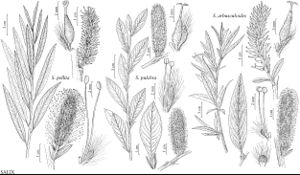Salix pellita
Bot. Gaz. 16: 106. 1891.
Shrubs, 0.5–6 m, (sometimes forming clones by stem fragmentation). Stems: branches (highly to ± brittle at base), red-brown, violet or yellow-brown, usually strongly glaucous, glabrescent; branchlets yellow-brown or red-brown, (usually strongly glaucous), glabrous or densely to sparsely pubescent or tomentose, (buds caprea-type). Leaves: stipules absent or rudimentary on early ones, rudimentary, absent, or foliaceous on late ones; petiole convex to flat, or shallowly grooved adaxially, 3–6.3–14 mm, (sometimes dark spherical glands distally), glabrous or pubescent adaxially; largest medial blade linear, lorate, or narrowly elliptic 40–79–123 × 6–12–20 mm, (2.3–)4.2–7.2–11.3 times as long as wide, base convex or cuneate, margins strongly or slightly revolute, entire, sinuate or sometimes crenulate, (glands submarginal or epilaminal), apex acuminate to acute, abaxial surface glaucous (sometimes obscured by hairs), densely villous, short-silky, woolly, or tomentose to glabrescent, hairs (white, sometimes also ferruginous), straight or wavy, adaxial slightly to highly glossy, glabrous, sparsely villous or pubescent (hairs white, sometimes also ferruginous); proximal blade margins entire; juvenile blade reddish or yellowish green, densely tomentose, short-silky, pubescent, or glabrous abaxially, hairs white, sometimes also ferruginous. Catkins flowering before leaves emerge; staminate stout, 20–39 × 7–20 mm, flowering branchlet 0–2 mm; pistillate densely flowered, slender, stout, or subglobose, 19–65(–80 in fruit) × 7–17 mm, flowering branchlet 0–7 mm; floral bract tawny, brown, or black, 1–2.6 mm, apex acute, convex, or rounded, abaxially hairy, hairs straight. Staminate flowers: adaxial nectary oblong or narrowly oblong, 0.6–1 mm; filaments distinct, glabrous or hairy basally; anthers purple turning yellow, ellipsoid, 0.4–0.6 mm. Pistillate flowers: adaxial nectary oblong to depressed-ovate, 0.3–1 mm, shorter than or equal to stipe; stipe 0.5–1.1 mm; ovary pyriform, short-silky, beak sometimes slightly bulged below styles; ovules 10–18 per ovary; styles 0.6–1.5 mm; stigmas slenderly cylindrical, 0.4–0.55–0.76 mm. Capsules 3.5–6.5 mm. 2n = 38.
Phenology: Flowering late Apr-late Jun.
Habitat: Sandy or gravelly floodplains, stream and lake margins, marshes, fens, coastal dunes, metamorphic or calcareous substrates
Elevation: 0-800 m
Distribution

St. Pierre and Miquelon, Man., N.B., Nfld. and Labr., N.S., Ont., Que., Sask., Maine, Mich., Minn., N.H., Vt., Wis.
Discussion
Salix pellita sometimes has foliaceous stipules on late leaves. When present, they are correlated with hairy rather than glabrous branchlets. There is no clear evidence of hybridity in such specimens but further study is indicated.
Vegetative specimens of Salix pellita can be difficult to separate from S. viminalis and S. ×smithiana in eastern Canada, where the latter were introduced for coarse basketry and have become naturalized. The introduced species usually are tall shrubs to small trees, with branches usually flexible at base and not strongly glaucous, and their leaves tend to be broader. In contrast, S. pellita is a mid shrub rarely to 6 m but never tree-like, its branches usually are highly brittle at the base and often strongly glaucous, and its leaves tend to be narrower.
See 85. Salix drummondiana for further comparative descriptions.
Hybrids:
Salix pellita forms natural hybrids with S. alaxensis var. alaxensis, S. discolor, S. pedicellaris, S. petiolaris, and S. planifolia.
Salix pellita × S. petiolaris: Leaves of this hybrid are distinctly serrate and flat, as in S. petiolaris, but branchlets are glaucous and bud gradation is caprea-type as in S. pellita. It is uncommon in eastern Saskatchewan.
Salix pellita × S. planifolia: This cross is suspected to occur in Labrador, Newfoundland, Quebec, and Ontario. Both parents are tetraploids and flower at the same time. The name S. pellita forma psila may apply to this hybrid.
Selected References
None.
